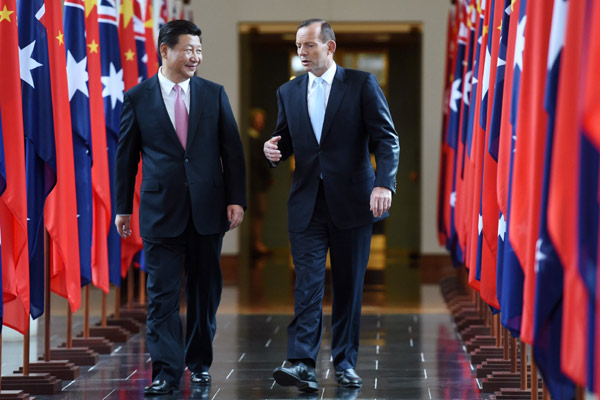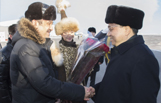How FTA with Australia benefit China?
(Chinadaily.com.cn) Updated: 2014-11-19 10:24
 |
|
President Xi Jinping and Australian Prime Minister Tony Abbott walk from Australia's House of Representatives chamber at Parliament House in Canberra on Monday. [Photo / Agencies] |
Australian cow: "It's a good thing for you."
Chinese cow:"How come?"
Australian cow: "If we enter the Chinese market, on the one hand, Chinese customers will get access to cheaper Australian dairy products of high quality; on the other hand, a more competitive environment will improve your living standards. Won't it?"
Chinese cow: You should get a doctorate in economics."
China and Australia on Monday signed a declaration of intent on concluding the free trade agreement (FTA). As the cows celebrate a better future, what benefits will the pact bring to ordinary Chinese people?
What's a FTA?
An international free trade agreement is an agreement that results from cooperation between at least two countries (or regions) to reduce trade barriers and increase trade with each other.
What will Chinese people get from FTA?
After the agreement takes effect, 85 percent of the products from Australia will enter the Chinese market tariff-free. Eventually, the historic deal will phase out tariffs for 95 percent of goods from Down Under. Thanks to the deal, it's likely that Chinese parents will no longer need purchasing agents to get high quality milk powder from Australia.
Besides dairy, China will get better access to Australian products like meat, wine, minerals, wool and agricultural products.
With regards to investment, both countries agreed to grant each other the most favored nation status once the FTA takes effect. They will greatly lower the review thresholds for corporate investment, increase market access opportunities, predictability and transparency for such investment, and, as a result, create job opportunities for people from both countries.
The agreement will also cover travel visa, e-commerce, government procurement, services and trade rules. Chinese producers will get a more stable supply of bulk commodities including minerals. This will reduce the imported inflationary pressure on China.
Currently, China has 20 FTAs under construction, among which 12 Agreements have been signed and implemented already.
Free trade agreements signed and implemented:
China-ASEAN FTA
China-Pakistan FTA
China-Chile FTA
China-New Zealand FTA
China-Singapore FTA
China-Peru FTA
Mainland and Hong Kong Closer Economic and Partnership Arrangement
Mainland and Macao Closer Economic and Partnership Arrangement
Economic Cooperation Framework Agreement
China-Costa Rica FTA
China-Iceland FTA
China-Switzerland FTA
Free trade agreement under negotiation:
China-GCC (Gulf Cooperation Council) FTA
FTA China-Australia FTA (Concluded)
China-Norway FTA
China-South Korea FTA (Concluded)
China-Japan-South Korea FTA
Regional Comprehensive Economic Partnership, RCEP
China-ASEAN FTA Upgrade Negotiations
China-Sri Lanka FTA
Free trade agreement under consideration:
China-India Regional Trade Arrangement Joint Feasibility Study
China-Columbia FTA Joint Feasibility Study
Preferential Trade Agreement:
Asia-Pacific Trade Agreement
Related news:
China-ROK-Japan FTA talks need stable relations:spokesman










